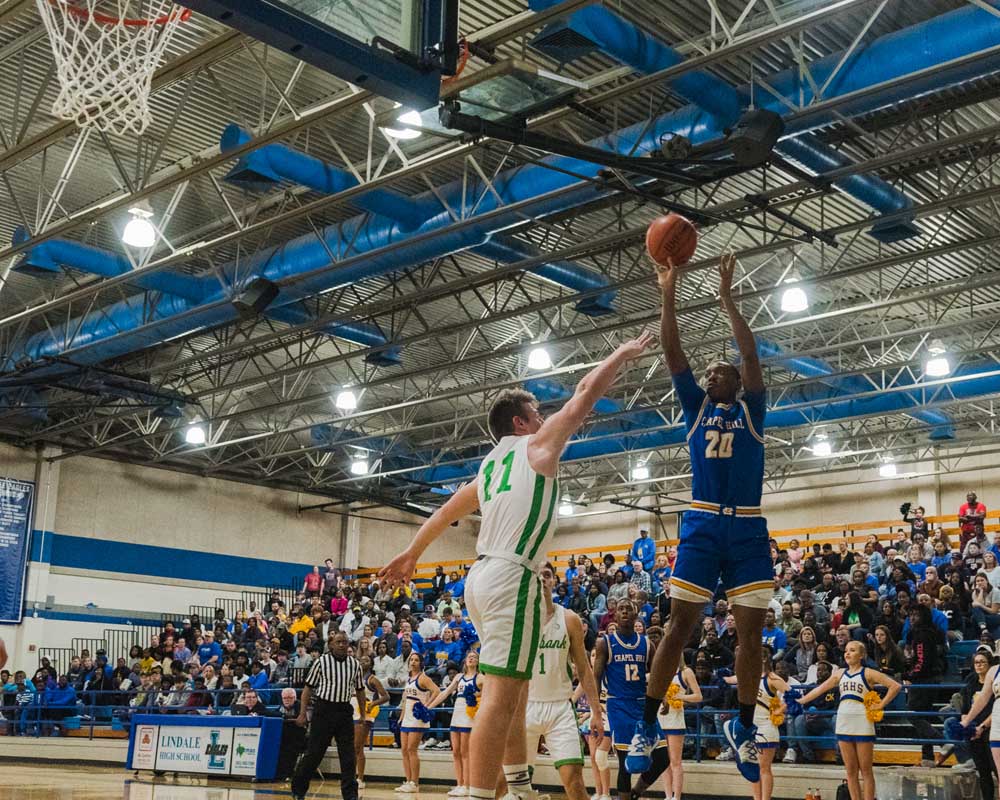Commentary: Elam Ending in high school basketball? It could work
Published 7:00 pm Tuesday, July 7, 2020

- Chapel Hill’s Jared Jones (20) goes up for a shot as Mabank’s Caleb Goforth (11) attempts to block during the Class 4A Region II area round on Feb. 28 at Lindale High School. Chapel Hill won 51-46 to advance to the third round.
Live sports are slowly returning, and one event that tipped off on Saturday is the seventh annual The Basketball Tournament.
Better known as the TBT, the event awards a prize of $1 million to the winning team.
Trending
Due to COVID-19, the tournament had to be condensed to 24 teams this year and is played in a single location.
But one part of The Basketball Tournament has remained the same, and that’s the Elam Ending.
The Elam Ending was devised by Ball State University professor Nick Elam. Whenever there is a dead ball with less than four minutes remaining in the game, the clock is turned off and the teams play to a target score.
At that time, eight points are added to the leading team’s score or if the game is tied, it is added to that score, and the teams will have the same amount of points remaining to reach the target score.
But let’s say Team A is leading Team B 80-68. The first team to 88 points would be declared the winner.
This format has been used for the TBT since its inception and was even implemented in this year’s NBA All-Star Game.
Trending
I’ve been a fan of the format from the beginning, and this past high school basketball season, I started thinking of reasons it could work for the high school basketball game.
People are often clamoring for a shot clock, but as many people who would prefer a shot clock be added to high school basketball, there are just as many on the other side who either think it’s a bad idea for the game or just not worth the cost and everything else that would have to take place to make it happen.
You don’t just have to buy the necessary equipment for a shot clock, but you also have to hire someone to work it correctly. I’ve witnessed that be a challenge at college games, so it’s evident that it would be difficult to make it happen at every high school in the state.
But the Elam Ending is a free alternative. Yes, it wouldn’t affect the first 28 minutes of the game, and teams would still be able to use stall tactics for the majority of the game. But it would eliminate that part of the game for the final four minutes.
There would be no reason to pull the ball out and try to burn the clock, because there would be no clock. Both teams would have the same objective of reaching the target score, thus forcing both teams to play all the way through the final whistle.
Another thing that sometimes draws fans away from basketball is the endless amount of fouls and parade of free throws near the end of a basketball game.
The losing team often has to intentionally foul at the end of games to stop the clock in order to have a chance at a comeback.
But with the Elam Ending, all they would have to do is play good enough defense to keep their opponent from scoring while scoring enough to reach the target score quicker.
No matter the deficit, the trailing team would feel like they still had a chance to win the game.
Running up the score is often a discussion when it comes to high school sports. And even with the Elam Ending, that wouldn’t go away.
But what it would do is eliminate the stigma of still playing hard even when you’re ahead by a lot of points.
Teams often feel compelled to have to stop trying just because they have a big lead and are often scolded if they continue to play hard or continue to score.
But with the Elam Ending in effect, once the clock reaches a certain point, it would be encouraged to continue to play until that target score is reached.
And if the UIL ever decided to adopt the Elam Ending, it could even opt to change the time mark the rule goes into effect based on the deficit of the game.
And the final perk of the Elam Ending?
All games end with a made basket.
Buzzer-beaters are a favorite aspect for many basketball fans. And while you wouldn’t get the true buzzer-beater with the clock winding down, every game would end with a winning shot.
And say the target score is 78 and the score is tied at 76 or 77-76, the intensity at both ends of the court would be at a high level.
Yes, it would eliminate overtime, which like most things would be well-received by some and opposed by others.
The Elam ending isn’t perfect, but it’s a system that works and could be very beneficial.
I don’t see it ever becoming a staple of the college or pro game, but it’s not out of the question.
In high school, though, it’s definitely worth considering.
TWITTER: @BrandonOSports






